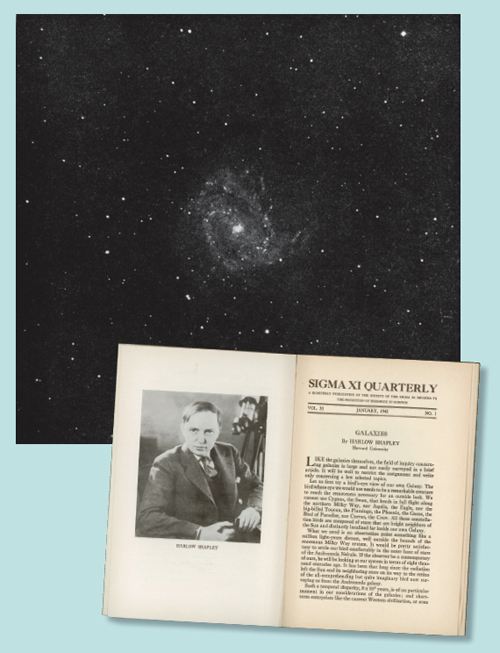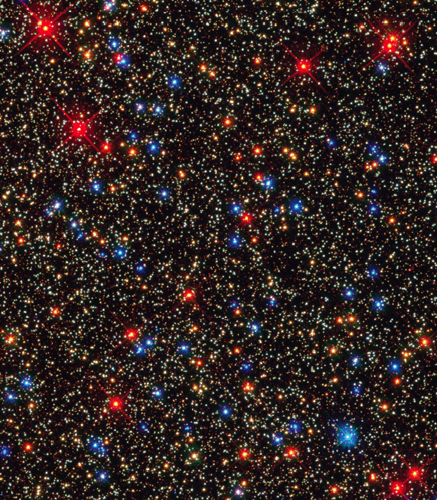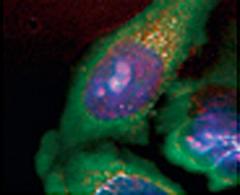
This Article From Issue
January-February 2011
Volume 99, Number 1
Page 56
DOI: 10.1511/2011.88.56
This article by Harlow Shapley originally appeared in the January 1942 issue of American Scientist,the first issue of the then-quarterly magazine to carry the name American Scientist. Virginia Trimble's commentary is further below.
Like the galaxies themselves, the field of inquiry concerning galaxies is large and not easily surveyed in a brief article. It will be well to restrict the assignment and write concerning only a few selected topics.
Let us first try a bird’s-eye view of our own Galaxy. The bird whose eye we would use needs to be a remarkable creature to reach the remoteness necessary for an outside look. We cannot use Cygnus, the Swan, that heads in full flight along northern Milky Way, nor Aquila, the Eagle, nor the big-billed Toucan, the Flamingo, the Phoenix, the Goose, the Bird of Paradise, nor Corvus, the Crow. All these constellation birds are composed of stars that are bright neighbors of the Sun and distinctly localized far inside our own Galaxy.

What we need is an observation point something like a million light-years distant, well outside the bounds of the enormous Milky Way system. It would be pretty satisfactory to settle our bird comfortably in the outer haze of stars of the Andromeda Nebula. If the observer be a contemporary of ours, he will be looking at our system in terms of eight thousand centuries ago. It has been that long since the radiation left the Sun and its neighboring stars on its way to the retina of the all-comprehending but quite imaginary bird now surveying us from the Andromeda galaxy.
Such a temporal disparity, 8 x 105 years, is of no particular moment in our considerations of the galaxies; and short-term enterprises like the current Western civilization, or even the whole history of mankind, can be neglected in the cosmic panorama as too momentary, too fleeting, for a clear recording.
It is well known that the Milky Way star system is a much flattened organization and that the Sun and planets are well inside. This interpretation of the Milky Way was pointed out one hundred and ninety years ago by Thomas Wright, a pioneer “bird’s-eye viewer’ of Durham, England. He saw that the hypothesis of a flattened stellar system with the Earth near the central plane would satisfactorily explain the Milky Way band as a phenomenon of projection in such a system.1 Our hypothetical observer in Andromeda would see this flattened wheel-shaped system not from the direction of its rim, nor from the direction of its axis, but from an intermediate position, galactic latitude –21°. It would appear in projection, therefore, as an elongated object, perhaps with the axes of the rough ellipse in the ratio of about three to one. There would be a conspicuous globular nucleus of naked-eye brightness.
1 For an account of the early cosmic interpretations by Thomas Wright and Immanuel Kant see the highly interesting account by F. A. Paneth, The Observatory (June, 1941), pp. 71 ff.; also H. Shapley, chap. v, Immanuel Kant, 1724–1924 (New Haven, Yale University Press, 1925), E. C. Wilm, ed.
We are almost certain now that our Galaxy is a great open-work spiral system of stars, perhaps not much unlike the system Messier 83, shown in Figure 1 (on the first page). But in linear measure it may be much larger than Messier 83. It has taken a long time to get conclusive evidence on the structure of our own system. We are badly located. There are obvious difficulties in residing inside. The meadow violet, no matter how bold and sensitive, is at a disadvantage in meadow topography compared with the bird hovering above.
For more than a hundred years astronomers have struggled with the problems of the structure of the Galaxy. There have been many speculators, but also some hard and systematic observers. Sir William Herschel dominated this field throughout the early part of the nineteenth century. His surveys of star clusters and nebulae, his measures of brightness and positions of various celestial objects, his interpretations of the accumulating material were so important that he is appropriately considered the founder of sidereal astronomy. Before him the emphasis was on comets and planets and the positions and motions of near-by stars and the laws governing these motions. It was essentially solar-system astronomy that attracted the telescopes and the wisdom of scientists until this German-Anglican organist of Bath devised some instruments; then astronomy turned outward to interstellar spaces.
Sir William Herschel was considerably baffled by the problem of the structure of the Galaxy and by the relation of clusters and nebulae to the Milky Way. His successors made many notable contributions, photometric and spectroscopic, to knowledge of the nature of stars and nebulae, but still the large cosmic problems remained baffling. Increasing telescopic strength, however, and the accumulation of many kinds and types of observations, eventually led to less puzzlement about the stellar neighbors of the Sun and the nearer parts of Milky Way. The old but unproved concept that the spiral nebulae and their relatives were external galaxies, coordinate with our own Milky Way system, gradually became established. The dimensions of the Galaxy and of the universe approached clarification, chiefly through the power of telescopes of American observatories and the vision of European and American theoreticians.
In clarifying some of the earlier puzzles, however, the astronomers only succeeded in opening vaster vistas for exploration, interpretation, and wonderment. The net gain has been considerable. It is no longer believed that the difficulties of certain astronomical enterprises have definitely blocked the progress of inquiry. A hundred years ago a distinguished scientist (not an astronomer) gloated a bit over the pronouncement that one thing would certainly forever remain unknown, namely, the chemical nature of the stars! It was not many years before the spectroscope began to betray him. Up to the time of her death Dr. Annie Cannon had classified more than half a million stars in detail on the basis of the chemistry of their surfaces. A great deal is now known of chemical constitution of a galaxy of a billion stars at a distance of ten million light-years. An elementary astronomical student can quickly learn, with the use of modern equipment about the hydrogen, calcium, iron, magnesium, helium, carbon, and the like in stars that have never actually been seen except by use of the photographic plate.

The moral of that bad ancient pronouncement about stellar chemistry is that it is not wise to be discouraged with the difficulties arising from our awkward location in the Galaxy. Eventually all the answers to all the questions you could now ask about Milky Way structure may be known. And, of course, then we would be wise enough to ask other questions that you could not answer, nor could we. Here are some the current questions, and, for some of them, preliminary answers.
1. Are the Sun and its planets in the middle of our discoidal Galaxy? They certainly are not. There are many lines of evidence which indicate that the center is far away in the direction of the region where the constellations of Sagittarius, Ophiuchus, and Scorpio come together, thirty degrees or a little more south of the celestial equator in the thick of the bright star clouds along the Milky Way. My early study of globular star clusters (a reproduction of an important 47 Tucanae, is shown in Figure 2) was instrumental in showing the observer that he is well out toward the rim of the wheel-shaped Galaxy. There may be some “subcenters” in other parts of the Milky Way, in far south Carina, for instance, and in Cygnus. But those conglomerations of stars appear to be important local structures within the great Galaxy that has its massive nucleus in the Sagittarius direction.
2. Is this Galaxy in motion as a unit? How it moves with respect to near-by galaxies is not yet very clear, but certainly rotates around the Sagittarius nucleus. It does not rotate as a solid wheel, at least at our distance from the nucleus. It rotates more as the planetary system rotates; the planets nearer the Sun go more rapidly and complete their “years” in shorter times than the remoter planets. We think we can very definitely measure the differential speed of stars around the nucleus. The average speed in the Sun’s neighborhood is about two hundred miles a second, and the direction of motion is toward the northern constellation of Cygnus.
3. How far are the Sun and the neighboring stars from the axis of rotation? Ten kiloparsecs is the approximate answer and, since a parsec is 3.26 light-years or about twenty trillion miles, the distance is something like 2 x 1017 miles, or thirty-odd thousand light-years. For various reasons, that value of ten kiloparsecs is not too certain, but it is well established that the center of gravity of our system is between eight and twelve kiloparsecs distant. The direction to the center is fixed with an uncertainty of only two or three degrees; this angular parameter is much easier to handle than the distance.
4. How large is the Milky Way system and how populous? Enormous in size and population, if non-quantitative terms may be used. There is good evidence that the total population in stars is of the order of two hundred thousand million, but the evidence on over-all dimensions is as yet inconclusive Indeed it is somewhat involved with definitions. For instance, what constitutes the boundary of a galaxy? Is it at the distance of the furthermost discoverable member of the system? Or is it the distance to the place where the number of stars per cubic light-year has decreased to a specified small quantity? Or is it, for a spiral galaxy, the distance to which a spiral arm can be traced? Or is it the distance to which an escaping star can go before the gravitational holdback is exceeded by the pull from some other galaxy?
The diameter of the system in its plane is not less than a hundred thousand light-years if all its recognizable stars are included. There is now good evidence that the wheel-shaped system is surrounded by a more or less spherical haze of stars, and some of the stars in the haze are fifty thousand light-years above the plane of the Milky Way. Probably this haze extends more distantly in the plane of the system and, therefore, the diameter of discoid plus haze considerably exceeds one hundred thousand light-years.
On the other hand, the diameter of our system in its plane might be measured as only fifty thousand light-years, or even less if we had to depend on photographic research equipment which, although comparable with our own, was located in the Virgo supergalaxy, several million light-years away. Our outer stars might not register. When our telescopes are turned on the members of that group in Virgo we can trace on the best of our long-exposure plates the largest individual galaxies only to a distance of ten or fifteen thousand light-years from their centers. Either those systems are very much smaller than ours, or we are unable to explore the faint regions that are as remote from the nuclei as we are from our nucleus in Sagittarius.
It might turn out, therefore, that the bird’s-eye observer from the Andromeda Nebula would report that our galactic system is no larger than the Andromeda Nebula; or, if the research were rather casual, the view might include only the nuclear portions of our galactic system, which might even be catalogued as a spheroidal galaxy. When we, in our turn, take a quick bird’s-eye view of the Andromeda galaxy, and measure its distance and dimensions, we immediately conclude that it is much smaller than we are, even though it is a giant compared with the average galaxy of our catalogues. But when the over-all extent of the Andromeda galaxy is studied with precise measuring apparatus, we double the dimensions as first seen and conclude that it is not very much smaller than the Milky Way system.
5. Why is it that we seem to be so baffled about the structure and dimensions of our own system, although we bravely go out to distances of one hundred million light-years in our explorations of other galaxies? What is so troublesome about measuring something that completely surrounds us and is near at hand?
That question finally brings out one feature of Milky Way structure which must be clearly seen at first glance by the observer in Andromeda, but which has taken us many years and much labor to discover and partially evaluate. This basic feature (and difficulty) is the presence throughout the Milky Way, especially near the Milky Way plane, of interstellar absorbing material—dust and gas, scattered and in clouds around the stars and in the spaces between them. Our vision is not clear; simple geometric relations between light and distance are incorrect because our observing station is in a fog that unevenly dims the light of the surrounding stars.
Gradually we are learning through studies of colors, and otherwise, how to make corrections for the interstellar absorption. It would not be difficult at all if the absorbing material were uniform. But the clouds of absorption are irregular. It is supposed that some of the greatest irregularities would be apparent to the Andromedan observer. At any rate, our own bird’s-eye views of hundreds of external galaxies show immediately the dark lanes between spiral arms, or across them, which indicate the interstellar absorption clouds that irregularly dim the star fields of those distant stellar system.
In summary, our imaginary bird’s-eye view has revealed our system as discoidal in its main body of stars, probably surrounded by a thinly populated spheroidal shell and dominated by a massive globular nucleus, which is some thirty thousand light-years from the Sun in an accurately measurable direction. Less certainly the view discloses that the Milky Way system is a spiral, perhaps more open in structure than the Andromeda galaxy; it is rotating at high speed, but even so two million centuries or possibly more will be required for the Sun and its neighbors to complete one circuit, to click off one cosmic year. Uncertainty remains as to over-all dimensions of the discoidal Galaxy and of its stellar haze, and the uncertainty arises in part from the light-absorbing, mostly non-luminous, interstellar material and from its irregular distribution and its dissimilar effectiveness on light at various wave lengths.
If, for a more distant view of this part of the universe we go off into space several million light-years in a special direction, the Andromeda Nebula and our galactic system would look like a pair of galaxies, separated by only a few diameters. And in the same field, apparently also a part of our local group of galaxies, would be the great spiral, Messier 33. A closer inspection from this distant point, and a careful measurement of distances, would show several fainter galaxies associated with these three large systems. Two of them would be faint companions of the Andromeda Nebula—Messier 32 and NGC 205; two of them would be our own satellite-companions, the Large and Small Clouds of Magellan. And there would be at least four other dwarf galaxies, two of them irregular in form, and two or more spheroidal.
The existence of this local cloud of galaxies, in which our system appears to be the big dominating member, seems to be now beyond question, but the census of its membership is not complete. All the known members are within a sphere of a million light-years diameter. Those unknown, or of uncertain membership, include systems wholly or partly concealed by clouds of absorption near the Milky Way plane. The rating of the great globular clusters is also not yet clear. A hundred globular clusters surround our galaxy, apparently subordinate members of the system, but the larger ones, like Omega Centauri and 47 Tucanae, should perhaps be ranked with the dwarf galaxies. In total luminosity and in mass they are comparable to NGC 205, the faint spheroidal galaxy in the Andromeda group. Our hypothetical Andromedan observer would probably record at least these two giant clusters as dwarf galaxies, if our own procedure with regard to classifying NGC 205 was followed.
Groups like the local “supergalaxy” occur elsewhere in Metagalactic space. A dozen rich clusters are known, some of them with hundreds of members, and a score or two of small groups, similar to our own, are already on record. One such is a group of objects in Fornax, in which the brightest are spheroidal; in our group the brightest galaxies are spiral or irregular in form.
Probably there are dwarf galaxies in the Fornax group, but as yet we have not identified them, nor have we found the Magellanic type. Because of the general tendency of the universe to expand and the galaxies and groups of galaxies to recede from one another, it may be that eventually we shall be able to say which faint objects in Fornax are members of the supersystem simply by determining their velocities in the line of sight. If the suspected galaxy is really much more distant than the average of the Fornax group, it will show a bigger “red shift” in the spectrum, a greater velocity of recession, and thus intimate the larger distance and non-membership.
On every expedition into remote corners of extragalactic space, it is necessary to equip ourselves with information on giant and supergiant stars. The reason is, obviously, that ordinary stars in far-off places are not recorded on our photographs; they are too dim. We must work with the giants. It may be of interest to consider the following highly luminous stars and types of stars and see how they contribute to knowledge of the Metagalaxy:
1. Supernovae
2. S Doradus
3. Novae
4. P-Cygni Stars and Others
1. “The most energetic catastrophe in the history of the world, unless it be creation itself,” is how I would describe the great violence of radiation and motion that accompanies the career of the supernova. Simply defined, a supernova results when a star blows up. Whether the disaster is caused or encouraged by head-on collision with another star or another something, or by the collapse of the star’s structure, with the consequent atomic transformation of mass into radiation, or “just happens,” we cannot yet say. More observational data are needed and are being obtained. The result of a supernova outburst is the outpouring of light in unparalleled fashion—a spurt of radiation the equivalent at times of fifty million suns and more. The burst of radiation lasts sometimes several days or weeks, quieting down slowly as the months go by. What remains after the flare-up? Perhaps a dense subdwarf star (the collapsed core of the original star); perhaps a hurriedly expanding nebula; perhaps just dust and ashes, and the Universe filling up with the dying glow of a radiant moment.
Dr. Fritz Zwicky of the California Institute of Technology has been the leader in recent years in the discovery of supernovae and in speculations concerning them. He thinks that neutrons and neutrinos play an important part in the supernova phenomenon. Certainly supernovae play a significant part in the history of the Universe. They are not too uncommon. About forty are on record, most of them discovered in the past ten years. Three of them appeared in our own galactic system. One hypothesis of the origin of the cosmic rays ties them up with the violence of the supernova.
The most distant individual stars yet photographed are some of the supernovae that are in galaxies tens of millions light-years distant. When more complete records are secured we shall be able to see if, at maximum brightness, they are sufficiently alike so that their apparent magnitudes at maximum can be used as a practical criterion of distance. At present there seems to be too large a dispersion in the intrinsic luminosities to make supernovae useful criteria in distance measurement in the Metagalaxy.
Long before supernovae were recognized, and long before there was the faintest notion of their enormous size as celestial phenomena, they played a very important part in astronomical development and knowledge of the Universe. For it happens that new stars suddenly appearing in 1572 and 1604 were important in the inspiration of two of the great astronomers of that time and of all time—Tycho Brahe, the Dane, and Johannes Kepler. Now we know that these stellar outbursts in Cassiopeia (Tycho’s star) and in Ophiuchus (Kepler’s stella nova) were most probably supernovae. Both stars rose to a brightness comparable with that of the brightest planet; both stars changed explosively fifteen magnitudes or more, an increase of brightness of more than a million times.
A third supernova of our galactic system was recorded by the Japanese and Chinese astronomers in 1054. The phenomenon was the parent of the present well-known Crab Nebula which is still rapidly expanding as a result of the eleventh-century disaster—eleventh century in our records, but five thousand years earlier on the cosmic clock.
2. The Supergiant S Doradus. The distinction of holding top place as a luminous star has been the lot of an object at the edge of one of the open clusters in the Large Magellanic Cloud. It is a variable star with average luminosity half a million times that of the Sun. It is somewhat exceeded in radiation output by supernovae, but they do not last, whereas S Doradus has been continuously radiating for the past half century, pouring out more than a hundred trillion tons of light per minute. It must have enormous resources to persist at such high luminosity. Is it perhaps some very slow type of supernova? The variations we now observe are irregular in character, but of no great moment in alleviating the expenditure of radiant energy. The spectrum of the star is of the rare P-Cygni type, which is indicative of unusually hot surface conditions. The Harvard photographic records of this star do not extend much before 1890, but of course there is little reason to suspect that S Doradus has been the supreme supergiant for only the past brief fifty years. Recent photographs with the large southern reflector have shown that stars nearly as bright as S Doradus are clustered around it, but unfortunately all of them are difficult to study because, notwithstanding their great intrinsic luminosities, the intervening distance of seventy-five thousand light-years dims the light so that even large telescopes can with difficulty make detailed analyses. None of the stars in the solar neighborhood is one tenth as bright as S Doradus.
3. Ordinary Novae. Several times a year, if we pay close attention, we find new stars in our own galactic system, especially in the direction toward the galactic center in Sagittarius. But daylight, clouds, moonlight, and astronomical inactivity contribute to our failure to record more than a few per cent of those that we know, from sampling, must be occurring. These new stars, or ordinary novae, behave much like the supernovae described above. But the phenomenon is much less violent, and a star is not sacrificed by each outburst. It is likely that the ordinary nova represents the explosive instability of the outer surfaces of a star. There is some indication that before explosion the ordinary novae are slightly subnormal stars of ordinary type. Perhaps this subnormality is at the bottom of the trigger action that sets them off.
But whatever the cause of the novae, it must be recorded as an interesting phenomenon, and one that probably is important in the general history of stars. In our own Galaxy, and in the neighboring Andromeda galaxy, these novae appear so frequently that when one thinks back over the past billion years that the Earth’s crust has existed, one concludes that very many stars have shot the works—a large proportion of them. Frequently we have remarked that novation is so common and time has been so long that every star might have blown up once, or will blow up during the next billion years—in other words, that evolution, or development, by way of the nova outburst is a major and not a negligible phenomenon in this world.
Evidence is accruing, however, that novation is a recurrent phenomenon. Four or five stars have been novae more than once, and two of them three times since 1860. If this be the true situation—only stars of peculiar character becoming novae—we may remain even more at ease with respect to the immediate future of our Sun. Its character is good and normal. We like to believe that the Sun is and always will be slightly variable (in the sun-spot period), and will remain quite dependable, undisturbed by interstellar clouds, unsusceptible to nova-inciting disturbance—at least for the next thousand years while the astronomers are finding out about the Universe. A nova-like change in the Sun would promptly wipe biology off the Earth, if it did not erase the planet altogether.
At maximum the ordinary novae are supergiant stars, more than ten thousand times the luminosity of the Sun, but scarcely one per cent as radiant as the average supernova. When novae appear in external galaxies they can be used as distance indicators because at maximum brightness the ordinary nova comes to about the same candlepower every time. Comparing the apparent brightness with the real brightness, the distance in light-years can readily be computed. Next to the Cepheid variables, novae are the best criteria for measuring distances of galaxies, providing there are enough found in any given system to stabilize the statistics.
4. Some Other Supergiants. Two or three magnitudes fainter than the notable S Doradus in the Large Magellanic Cloud are a number of others of the same peculiar spectrum, which are termed the P-Cygni type. There is evidence, not quite conclusive, that these stars are related to the novae, differing most conspicuously, of course, in the property of remaining at high luminosities and not fading away after the impulsive outburst. But in addition to these bluish hot stars we find in the Magellanic Clouds supergiant red stars, almost as bright. Some of them are variable, and some are, indeed, long-period Cepheid variables, ten thousand times as bright as the Sun. Many resemble the famous red giants of our neighborhood, Antares and Betelgeuse. A few greatly exceed the local red supergiants in volume as well as in radiation output. Diameters of the order of the radius of Jupiter’s orbit, volumes ten million times that of the Sun, are indicated. These preposterous dimensions are derived by knowing the distance of the Magellanic Cloud, the total candlepowers of these supergiant stars, and the spectra which indicate low efficiency as radiators. In order to give out so much radiation, the emitting surfaces must be exceedingly large. The star S Doradus, on the other hand, which is a more efficient radiator, is much smaller and denser than the Antares-like supergiants.
Adjacent to the Small Magellanic Cloud is the great globular cluster, 47 Tucanae, already mentioned as an intermediate between normal galaxies and normal star clusters. Its three brightest stars appear to be typical long-period variable stars, but they are not typical in one respect. Their luminosities at maximum are three or four magnitudes brighter than long-period variable stars, which are typified by Mira (The Wonderful) Ceti, the first of known variables. It is peculiar, too, that the three supergiant variables in the cluster rise to almost exactly the same magnitude at maximum, and all have periods of about two hundred days. This is one of the coincidences that the laws of chance do not easily condone; there must be some deep significance for stars or star clusters in the unusual performance of these supergiants.
Both blue and red supergiants appear sporadically in our own galactic system; probably the occasionally detectable highly luminous stars in external galaxies also belong to various spectral classes. Dr. Hubble has effectively used the luminosities of these invariable stars, along with the available information on Cepheid variables and ordinary novae, to get the distances of galaxies that are not more than a few million light-years away. If a galaxy is as much as twenty million light-years distant, even these supergiants cannot be individually photographed with present telescopic and photographic equipment, and resort must be made to other photometric means of estimating distances. Ordinary giant stars, like Vega and Arcturus, are not yet photographed in any but the very nearest galaxies, and stars of average mass and luminosity, like the Sun, have so far not been photographed outside our own galactic system.
The future of research on galaxies probably depends not so much on the size of telescopes as on the speed and resolution of photographic plates and on other radiation-registering devices. But even without better facilities than those at present available, astronomers have plenty to do in galactic research, for within reach are a thousand million individual stars in our own Galaxy, and at least ten million other galaxies.
Shaping Up Shapley: A Commentary
Virginia Trimble
Harlow Shapley was the Copernicus of the Milky Way. Copernicus got our Earth out of the center of the solar system, and Shapley got the solar system out of the center of the Galaxy, though the methods the two used were very different; Copernicus carried out long calculations (pre-slide-rule and pre-log-tables, not just pre-computer) which showed that a sun-centered model of the solar system could do just as good a job as an earth-centered one in predicting positions of the sun, moon and planets in the sky. Shapley looked at many variable stars (called Cepheids) in a class of star clusters (called globulars), measured their distances, and thereby showed that we live very far from the center of the system of clusters. It took a century before most astronomers were Copernicans, but only a few years for acceptance of Shapley’s picture of the Galaxy. Contrary to popular superstition, Copernicus needed almost as many epicycles as Ptolemy had used. And Shapley needed to make several assumptions and approximations that eventually ruled out his distance scale, while leaving his main conclusion intact.

Image courtesy of NASA.
Although Shapley in due course became known as a world expert on galaxies (hence his article!) and served as President of the Commission on Galaxies (then called Nebulae and Star Clusters) of the International Astronomical Union (IAU), the story of his involvement with the concept was not entirely a happy one. He arrived at Mt. Wilson Observatory in 1914 with a Princeton Ph.D. earned for analyzing the light curves of eclipsing binary stars. And he was then a supporter of the concept of “island universes,” the idea that certain smudgy things in the sky were systems of stars comparable with our own Milky Way.
Then Shapley’s own work of the next five years persuaded him that our Galactic star system was a factor of 10 or more larger than the previously accepted size and, therefore, that the spiral nebulae were most unlikely to be comparable systems. About a dozen different lines of evidence, many spurious (see Trimble, 1995), tied him to this view by 1920. This was the year when officers of the U.S. National Academy of Sciences invited him and Heber Doust (rhymes with soused) Curtis to present talks the same evening on “The Distance Scale of the Universe.” This they did, their honoraria of $150 each covering travel from Mt. Wilson for Shapley and from Lick Observatory for Curtis. The event is now usually called “The Curtis-Shapley Debate,” though the format was that of two lectures, not a debate. Curtis was expected to, and did, defend a picture of the Milky Way about 10,000 parsecs1 in diameter with us near the center, while Shapley plumped for up to 120,000 parsecs, with the sun 20 kiloparsecs from the center (but still very close to the midplane). In addition, Curtis said “Island universes, yes,” and Shapley said “Island universes, no!” In brief summary, Curtis was right about Island Universes, Shapley about our non-central location, and our current number for the size of the Milky Way is close to the average of their two numbers.
Within a year, both had moved. Curtis became director at Allegheny Observatory and later at Michigan. And Shapley was ensconced as director at Harvard Observatory by the time Edwin Powell Hubble announced the discovery of Cepheid variables in three of those smudgy, spiral things, called M33, NGC 6822 and M 31 (the Andromeda Nebula). He wrote to Shapley before the public announcement—scientists were gentlemen in those days, even when they were ladies. Shapley showed the letter to his then graduate student Cecilia H. Payne (later Gaposochkin) with the remark, “Here is the letter that destroyed my universe.” (Haramundanis 1996, p. 209) Neither Shapley nor Curtis ever again had access to a large telescope.
Meanwhile Hubble went on to use the 100-inch at Mt. Wilson, commissioned in 1917, to find Cepheids in more “spiral nebulae,” use them to calibrate other distance indicators, and to put his distances together with redshifts measured by Vesto Melvin Slipher at Lowell Observatory. He found a linear redshift-distance relation, now called the expansion of the universe. Shapley necessarily accepted this, but he does not sound enthusiastic about either the expansion or about the use of redshifts to determine galactic motion or membership in clusters.
So, what had gone right and what wrong up to 1920, from 1920 to 1942, and since then?
En route from Princeton to Mt. Wilson, Shapley visited Harvard, where Solon Bailey urged him to use the Mt. Wilson 60-inch (then the largest telescope in the world) to study variable stars in globular clusters outside the plane of the Milky Way, rather than continuing his thesis work on eclipsing stars in the plane.2
1 What is a parsec? It is the distance to a star from which an observer looking back at us would see the earth-sun distance to be exactly one arc-second on the sky. It is the official IAU unit of distance for things outside the solar system and handy for stellar astronomers because it is close to the average distance between stars near us. Galaxy sizes are typically kpc, distances between them Mpc and the size of the observable universe about 5 Gpc.
2 Encountering Solon in quick succession after Vesto Melvin, Heber Doust, and Harlow may leave you wondering where astronomer’s mothers found their names.

Image courtesy of NASA.
The advice came at a critical moment. H. C. Plummer at Dublin and Shapley himself had just shown that the Cepheid variables could not be eclipsing binaries, because one star would have to be inside the other to account for the periods. Rather, they were pulsating as if breathing in and out, suggesting that they might all have the same physics. Then, if the correlation between periods and brightnesses seen for variables in the Large Magellanic Cloud in 1908–12 by Henrietta Swan Leavitt could somehow be calibrated, astronomers would be able to measure distances anywhere they saw these pulsating stars, for instance to establish the size of the Milky Way and our distance from its center. The majority of astronomers from William Herschel around 1800 to Jacobus Kapteyn and Curtis up to 1920 had thought we were very close to the center of a small stellar system.
Shapley attempted the essential calibration, using a method called statistical parallax. This had been invented and tried in 1913 by Einar Hertzsprung. To make it work, you need to know velocities of a group of stars along your line of sight to them, their apparent motions in the sky and that they are a homogeneous group with random real speeds. Four things went wrong. (1) Shapley could not include the non-random motion of rotation of the Galaxy (not discovered until 1926). (2) He assumed that there was no absorption of starlight in its travel to us (roughly right for the globular clusters; badly wrong for his calibrating Cepheids in the plane). (3) He had slightly bad luck with inaccurate measurements of small numbers by several other observers. And (4) he had decided that the cluster variables (now called RR Lyraes) were the same sort of beast as the Cepheids in the galactic plane and in the Large Magellanic Cloud. The net result was to make the Milky Way look much larger than it really is and the distance to other galaxies look smaller by factors of about three nearby and ten at larger distances. See Fernie (1969) for the details.
The Milky Way numbers had been sorted out by 1942. But extragalactic distances used by Hubble in his redshift-distance relation, and by everybody else up until the mid-1950s, remained much too small. Thus it was that Shapley says our Local Group is dominated by the Milky Way, and other writers from the 1920s and later spoke of “cake and biscuits” or “if the others are Islands, the Milky Way is a continent.”
The extragalactic distance scale improved in many steps (Trimble 1996) to what we now think is the right answer (to better than 10 percent) coming from a “Key Project” using the Hubble Space Telescope (Freeman et al. 2001). But, meanwhile, and it was a long while, other galaxies came out much too small, and the apparent age of the universe given by distances divided by redshifts, was about 1.8 billion years, less than the known age of the Earth, and of the Sun and other stars, when they began to be understood just after World War II. Getting this right, so that the Milky Way is merely a typical largish spiral in a 13.7 billion-year-old cosmos, is undoubtedly the most important change since the article was written.
What else? First there were some things that he got much righter than you might reasonably have expected. The globular clusters Omega Centauri and 47 Tucanae are indeed either the remnant cores of dwarf spheroidal (dSph) galaxies or some intermediate class of object. We say this now because they show several populations of stars of different ages and chemical compositions. None of those data existed in 1942, though he should have known better than to attribute Annie J. Cannon’s spectral types to surface compositions of stars, because his own student, Cecilia Payne, had shown that the main cause was different temperatures.
Shapley’s final point about detectors being more important than bigger telescopes is also correct. In 1942, there was the 100-inch (2.5 meter) at Mt. Wilson, and the pieces of what would become the Palomar 200-inch bogged down in various places. The largest we have now are 10-meter mirrors, a factor of four increase in diameter and of 16 in “light-collecting power.” Meanwhile, the efficiency of detectors has increased by something like 350, from an efficiency of 0.1 percent for turning photons into silver grains on plates to 35 percent for turning photons into electrons in CCD cameras. Since you can’t get better than 100 percent, we are of course now coveting larger mirrors!

Image courtesy of NASA/JPL-Caltech/VLA/MPIA.
It should be said, however, that Shapley was not a fan of large telescopes. His “large” southern reflector must have been a 36-inch, and many of the plates from which he convinced himself that most galaxies live in groups and clusters came from even smaller facilities. These show larger patches of sky than 100-inch plates can, and Shapley said on occasion that Hubble’s problem, in concluding that most galaxies are scattered at random across the sky, was that his telescopes were too big!
Other changes, not all of enormous importance, have occurred in astronomy and in astronomical writing since 1942. Shapley clearly expected his readers to be more familiar with the night sky than most of our current Sigma Xi colleagues are, including some astronomers for whom Cygnus is a box on the sky best observed in the summer, if they think about it at all. Candlepower as a synonym for brightness or luminosity would also have been more familiar. Our current students are entirely puzzled by the phrase “standard candle,” probably never having noticed that nearly all real candles are nearly the same brightness. Why this is so was put to me as a lunch-time question by Richard Feynman years ago, and it is left as an exercise for the reader to figure it out. There are surely other aspects of the writing style that you young folks will be more aware of than I. My mother was born the year after Harlow Shapley, about 300 miles away, and was one of my best friends until her 1984 death.

Image courtesy of NASA/CXC/U. Leicester/U. London/R. Soria and K. Wu.
Scientific progress can be approximately divided into observations (data) and theory (understanding). Many of the observational developments since Shapley wrote were entirely predictable, given better detectors on larger telescopes. At last count, the Local Group had about 37 members rather than seven, the new ones being a mix of dwarf irregulars and, mostly, dSphs. Some were found on photographic plates from the Palomar Observatory Sky Survey, often by Alan Whiting (who has a Ph.D. from Cambridge but is now the Third Assistant Engineer on a ship), many more from the Sloan Digital Sky Survey (SDSS) using CCD cameras. The Sloan folks publish in committees, but let me just mention James E. Gunn, who conceived, built and guided the project for many years, and Heidi Newberg, first author on a few of the papers, because I like them.3
The numbers of imageable and known stars, other galaxies and clusters of galaxies have all increased by orders of magnitude, including individual stars in other galaxies and dSphs in quite distant clusters. The motion of the Milky Way has been established accurately, though it took the discovery and mapping of the 3K-microwave, black body, cosmic background radiation to do it. In principle, this motion could also have been derived from accurate values of redshifts for very many galaxies in all directions. Galaxies are indeed essentially all grouped and clustered, even ones in volumes of the universe with less than average density. And dwarfs are the commonest sort, found everywhere you can look faint enough.
On the theoretical side, Shapley says nothing about formation and evolution of galaxies and large-scale structure, now quite possibly the single largest subfield of astronomy and cosmology. Sir James Jeans in 1942 had things to say, mostly about gravitational contraction and what we now call the Jeans mass (so did he, but not in public) that were at least on the right track. The topic is now largely tackled by comparing SDSS-type observations with computer simulations that start with mass elements of dark matter and follow their interactions and sweeping up of hydrogen and helium gas. Although the phrase “dark matter” first appeared in print in 1922, it then meant very faint stars and perhaps gas and dust. Shapley does not mention it as part of the Milky Way or other galaxies. When he says that Omega Cen and 47 Tuc have the same luminosity and mass as the then-known dSph galaxies, he means just the mass belonging to the stars that radiate the light.

Image courtesy of NASA.
The discussion of very bright stars is perhaps the least satisfactory part of the article to modern eyes. Brightnesses of supernovae, novae and what are now called Hubble-Sandage variables are distorted by varying amounts by the distance-dependent errors in Shapley’s distance scale. He supposes that novae must be important in the great scheme of things and supernovae not, because the former are also much more common, and because he thinks that novae might be used as distance indicators. In fact supernovae are essential to the buildup of all the other elements from hydrogen and helium, and one class (called Type la supernovae) is now our best “meter stick” at multi-gigaparsec distances. Novae are minor nuclear bombs on the surfaces of white dwarfs with ordinary companion stars. He notes correctly that they must recur and has, mercifully, abandoned the nova mechanism he supported in the 1920 debate, where a nova occurs when a previously existing star moves into a previously existing gas cloud.
The discussion of S Doradus, P Cygni and similar stars has, and could have had, no sense that these are associated with regions where massive stars are currently forming, because he wrote at a time when the majority of astronomers did not actually think that star formation was an ongoing process.
Shapley’s article is now nearly 70 years old, and my first one goes back a smidge less than 50 years. How many of my early ones would I volunteer to have read and criticized somewhere around 2035? Well, maybe the one on Cheops pyramid from 1963. One’s first thought is that at least history papers don’t go out of date. But this is not entirely so. Shapley makes two historical remarks, one about Thomas Wright’s recognition of the disk shape of the Milky Way and one about the significance of the “novae stellae” of 1572 and 1604 studied by Tycho and Kepler. A modern historian of science would probably want to adjust both, to point out that Wright’s total universe had some much-less-realistic components and that the SN 1604 event came after Kepler had already been appointed Imperial Astronomer at Prague, following the death of Tycho.
3 Probably I should take warning from C. H. Payne-Gaposchkin (Haramundanis p. 227) that it is dangerous to believe one’s colleagues’ results because one likes them. She had in mind the acceptance by Shapley of Adriaan van Maanen’s claim that he could see rotation in the plane of the sky of some spiral nebulae, which would have made it impossible for them to be located outside the Milky Way.
Bibliography
- Fernie, J. D. 1969. The period-luminosity relation: A historical review. Publications of the Astronomical Society of the Pacific 81:707.
- Freedman, W. H., et al. 2001. Final results from the Hubble Space Telescope key project to measure the Hubble constant. Astrophysical Journal 553:47.
- Haramundanis, K., Editor. 1996. Cecilia Payne-Gaposchkin, 2nd edition. Cambridge University Press.
-
- Smith, H. A., and V. Trimble. 2007. Harlow Shapley. In Biographical Encyclopedia of Astronomers, ed. T. Hockey et al. Springer, p. 1048.
- Trimble, V. 1995. The 1920 Shapley-Curtis discussion: Background, issues, and aftermath. Publications of the Astronomical Society of the Pacific 107:1133.
- Trimble, V. 1996. The incredible shrinking constant 1925–1975. Publications of the Astronomical Society of the Pacific 108:1073.

American Scientist Comments and Discussion
To discuss our articles or comment on them, please share them and tag American Scientist on social media platforms. Here are links to our profiles on Twitter, Facebook, and LinkedIn.
If we re-share your post, we will moderate comments/discussion following our comments policy.